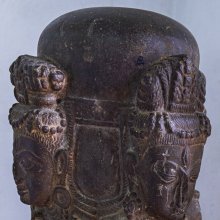Phallus, Phalli: 1 definition
Introduction:
Phallus means something in Hinduism, Sanskrit. If you want to know the exact meaning, history, etymology or English translation of this term then check out the descriptions on this page. Add your comment or reference to a book if you want to contribute to this summary article.
Images (photo gallery)
In Hinduism
Shilpashastra (iconography)
Source: Shodhganga: Elements of Art and Architecture in the Trtiyakhanda of the Visnudharmottarapurana (shilpa)The Phallus is denoted in by the Sanskrit term Liṅga and is associated with Śiva, whose iconography has been described in the third part of the Viṣṇudharmottarapurāṇa, an ancient Sanskrit text which (being encyclopedic in nature) deals with a variety of cultural topics such as arts, architecture, music, grammar and astronomy.—The Viṣṇudharmottarapurāṇa shows the reference of five faces of Lord Śiva. A point to be noted here is that liṅga or phallus is worshiped as an icon of Lord Śiva. According to the Śivapurāṇa, the phallus is the emblem i.e. the sign of union of Lord Śiva and Śakti, for whom it is the symbol. Sometimes the liṅga is seen to be associated with faces and in the five faced phallus, the face of Īśāṇa should be on the top and the other four faces should face four direction viz. east, south, west and north respectively. In the Budhanilakantha Temple of Nepal, a phallus with five faces is seen to be worshiped.

Shilpashastra (शिल्पशास्त्र, śilpaśāstra) represents the ancient Indian science (shastra) of creative arts (shilpa) such as sculpture, iconography and painting. Closely related to Vastushastra (architecture), they often share the same literature.
See also (Relevant definitions)
Full-text (+38): Linga, Lingamurti, Ekalinga, Shishnadeva, Shivalinga, Pratilingam, Lingapitha, Lingapratishthavidhi, Lingarccana, Mahalinga, Pindi, Maror phalli, Mung-phalli, Limgopasana, Yageshvara, Shishna, Ling, Limga, Shisn, Pumshcamka.
Relevant text
Search found 38 books and stories containing Phallus, Phalli; (plurals include: Phalluses, Phallis). You can also click to the full overview containing English textual excerpts. Below are direct links for the most relevant articles:
Manasara (English translation) (by Prasanna Kumar Acharya)
Chapter 52 - The phalli/phallus (liṅga)
Chapter 53 - The altar (pīṭha-lakṣaṇa)
Samarangana-sutradhara (Summary) (by D. N. Shukla)
Chapter 71 - Iconography of the Phalli (liṅga) and their Pedestals (pīṭha)
Dvisahasri of Tembesvami (Summary and Study) (by Upadhyay Mihirkumar Sudhirbhai)
Chapter 6 - Description of holy place called Gokarṇa
Chapter 19 - Narration of the Greatness of the Devotion
Puranic encyclopaedia (by Vettam Mani)
The Padma Purana (by N.A. Deshpande)
Chapter 151 - Dhavaleśvara < [Section 6 - Uttara-Khaṇḍa (Concluding Section)]
Chapter 34 - The Greatness of Kṛttivāseśvara < [Section 3 - Svarga-khaṇḍa (section on the heavens)]
Chapter 156 - Candreśvara < [Section 6 - Uttara-Khaṇḍa (Concluding Section)]
The Shiva Purana (by J. L. Shastri)
Chapter 12 - The reason for Śiva’s assuming the phallic form (liṅga) < [Section 4 - Koṭirudra-Saṃhitā]
Chapter 5 - The greatness of the phallic emblem (liṅga) of Śiva < [Section 1 - Vidyeśvara-saṃhitā]
Chapter 18 - The greatness of the Jyotirliṅga Oṃkāreśvara < [Section 4 - Koṭirudra-Saṃhitā]
